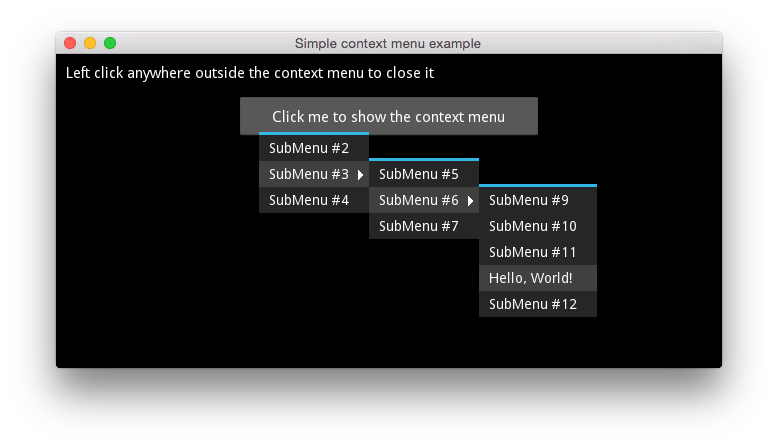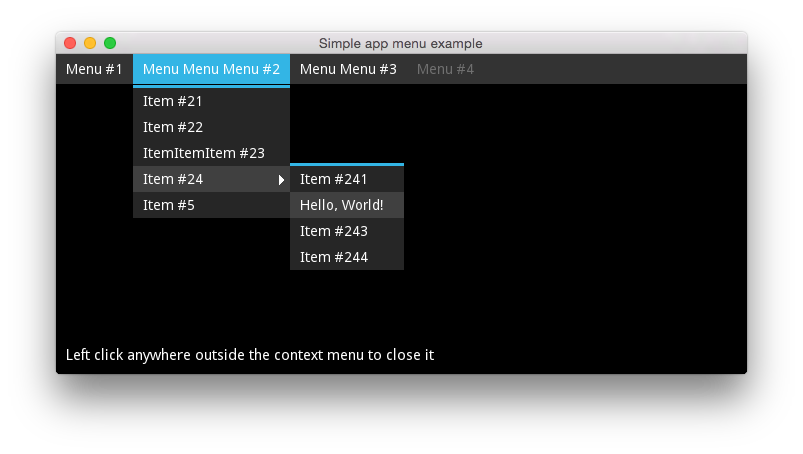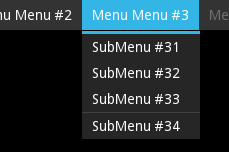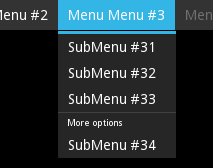Mercurial > libervia-desktop-kivy
view src/libs/garden/garden.contextmenu/README.md @ 116:8576d70ff803
chat: message header is hidden for info messages
| author | Goffi <goffi@goffi.org> |
|---|---|
| date | Thu, 26 Jan 2017 20:39:32 +0100 |
| parents | 741a7d6d8c28 |
| children |
line wrap: on
line source
# garden.contextmenu Collection of classes for easy creating **context** and **application** menus. ## Context Menu  Context menu is represented by `ContextMenu` widget that wraps all menu items as `ContextMenuTextItem` widgets. Context menus can be nested, each `ContextMenuTextItem` can contain maximum one `ContextMenu` widget. ```python import kivy from kivy.app import App from kivy.lang import Builder import kivy.garden.contextmenu kv = """ FloatLayout: id: layout Label: pos: 10, self.parent.height - self.height - 10 text: "Left click anywhere outside the context menu to close it" size_hint: None, None size: self.texture_size Button: size_hint: None, None pos_hint: {"center_x": 0.5, "center_y": 0.8 } size: 300, 40 text: "Click me to show the context menu" on_release: context_menu.show(*app.root_window.mouse_pos) ContextMenu: id: context_menu visible: False cancel_handler_widget: layout ContextMenuTextItem: text: "SubMenu #2" ContextMenuTextItem: text: "SubMenu #3" ContextMenu: ContextMenuTextItem: text: "SubMenu #5" ContextMenuTextItem: text: "SubMenu #6" ContextMenu: ContextMenuTextItem: text: "SubMenu #9" ContextMenuTextItem: text: "SubMenu #10" ContextMenuTextItem: text: "SubMenu #11" ContextMenuTextItem: text: "Hello, World!" on_release: app.say_hello(self.text) ContextMenuTextItem: text: "SubMenu #12" ContextMenuTextItem: text: "SubMenu #7" ContextMenuTextItem: text: "SubMenu #4" """ class MyApp(App): def build(self): self.title = 'Simple context menu example' return Builder.load_string(kv) def say_hello(self, text): print(text) self.root.ids['context_menu'].hide() if __name__ == '__main__': MyApp().run() ``` Arrows that symbolize that an item has sub menu is created automatically. `ContextMenuTextItem` inherits from [ButtonBehavior](http://kivy.org/docs/api-kivy.uix.behaviors.html#kivy.uix.behaviors.ButtonBehavior) so you can use `on_release` to bind actions to it. The root context menu can use `cancel_handler_widget` parameter. This adds `on_touch_down` event to it that closes the menu when you click anywhere outside the menu. ## Application Menu  Creating application menus is very similar to context menus. Use `AppMenu` and `AppMenuTextItem` widgets to create the top level menu. Then each `AppMenuTextItem` can contain one `ContextMenu` widget as we saw above. `AppMenuTextItem` without `ContextMenu` are disabled by default ```python import kivy from kivy.app import App from kivy.lang import Builder import kivy.garden.contextmenu kv = """ FloatLayout: id: layout AppMenu: id: app_menu top: root.height cancel_handler_widget: layout AppMenuTextItem: text: "Menu #1" ContextMenu: ContextMenuTextItem: text: "Item #11" ContextMenuTextItem: text: "Item #12" AppMenuTextItem: text: "Menu Menu Menu #2" ContextMenu: ContextMenuTextItem: text: "Item #21" ContextMenuTextItem: text: "Item #22" ContextMenuTextItem: text: "ItemItemItem #23" ContextMenuTextItem: text: "Item #24" ContextMenu: ContextMenuTextItem: text: "Item #241" ContextMenuTextItem: text: "Hello, World!" on_release: app.say_hello(self.text) # ... ContextMenuTextItem: text: "Item #5" AppMenuTextItem: text: "Menu Menu #3" ContextMenu: ContextMenuTextItem: text: "SubMenu #31" ContextMenuDivider: ContextMenuTextItem: text: "SubMenu #32" # ... AppMenuTextItem: text: "Menu #4" # ... # The rest follows as usually """ class MyApp(App): def build(self): self.title = 'Simple app menu example' return Builder.load_string(kv) def say_hello(self, text): print(text) self.root.ids['app_menu'].close_all() if __name__ == '__main__': MyApp().run() ``` ## All classes `garden.contextmenu` provides you with a set of classes and mixins for creating your own customised menu items for both context and application menus. ### context_menu.AbstractMenu Mixin class that represents basic functionality for all menus. It cannot be used by itself and needs to be extended with a layout. Provides `cancel_handler_widget` property. See [AppMenu](https://github.com/kivy-garden/garden.contextmenu/blob/master/app_menu.py) or [ContextMenu](https://github.com/kivy-garden/garden.contextmenu/blob/master/context_menu.py). ### context_menu.ContextMenu Implementation of a context menu. ### context_menu.AbstractMenuItem Mixin class that represents a single menu item. Needs to be extended to be any useful. It's a base class for all menu items for both context and application menus. If you want to extend this class you need to override the `content_width` property which tells the parent `ContextMenu` what is the expected width of this item. It needs to know this to set it's own width. ### context_menu.ContextMenuItem Single context menu item. Automatically draws an arrow if contains a `ContextMenu` children. If you want to create a custom menu item extend this class. ### context_menu.AbstractMenuItemHoverable Mixin class that makes any class that inherits `ContextMenuItem` to change background color on mouse hover. ### context_menu.ContextMenuText Menu item with `Label` widget without any extra functionality. ### context_menu.ContextMenuDivider Menu widget that splits two parts of a context/app menu.  It also contains an instance of `Label` which is not visible if you don't set it any text. ```python ContextMenuTextItem: text: "SubMenu #33" ContextMenuDivider: text: "More options" ContextMenuTextItem: text: "SubMenu #34" ```  ### context_menu.ContextMenuTextItem Menu item with text. You'll be most of the time just fine using this class for all your menu items. You can also see it used in [all examples here](https://github.com/kivy-garden/garden.contextmenu/tree/master/examples). Contains a `Label` widget and copies `text`, `font_size` and `color` properties to it automatically. ### app_menu.AppMenu Application menu widget. By default it fills the entire parent's width. ### app_menu.AppMenuTextItem Application menu item width text. Contains a `Label` widget and copies `text`, `font_size` and `color` properties to it automatically. # License garden.contextmenu is licensed under MIT license.
